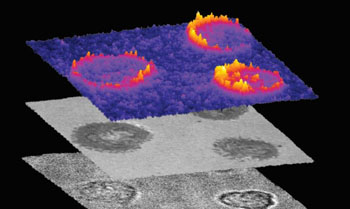Nanoprobes Enable Measurement of T-Cell Binding Forces
By LabMedica International staff writers
Posted on 02 Jun 2016
A team of biochemical engineers has demonstrated that activation of immune system T-cells by foreign antigens has a physical component that is just as important to the process as immunochemical recognition.Posted on 02 Jun 2016
T-cells are triggered when the T-cell receptor (TCR) encounters its antigenic ligand, the peptide-major histocompatibility complex (pMHC), on the surface of antigen presenting cells (APCs). Because T-cells are highly migratory and antigen recognition occurs at a junction where the T-cell physically contacts the APC, there are long-standing questions of whether T-cells transmit defined forces to their TCR complex and whether biophysical coupling influences immune function.

Image: A three-dimensional rendering of a fluorescence image maps the piconewton forces applied by T-cells. The height and color indicates the magnitude of the applied force (Photo courtesy of Yang Liu, Emory University).
In an attempt to answer these questions investigators at Emory University (Atlanta, GA, USA) developed DNA-based gold nanoparticle tension sensors that fluoresce in response to a mechanical force as small as one piconewton (10 to the minus 12 newtons). The investigators designed a series of experiments in which mouse T-cells interacted with a series of eight amino acid peptide ligands that differed in the number four amino acid position. The amount of force that was applied by the T-cell was mapped using tension probes of different reactivity. Probes that responded to greater than 19 piconewtons did not fluoresce, while probes that reacted to less than 12 piconewtons produced a high signal. Video obtained through a fluorescent microscope enabled the investigators to measure and record the responses of the T-cells as they moved across the ligands.
Results published in the May 2, 2016, online edition of the journal Proceedings of the [U.S.] National Academy of Sciences revealed that naïve T-cells harnessed cytoskeletal coupling to transmit from 12-19 piconewtons of force to their TCRs within seconds of ligand binding and preceding initial calcium signaling. CD8 coreceptor binding and lymphocyte-specific kinase signaling were required for antigen-mediated cell spreading and force generation. T-cells displayed a dampened and poorly specific response to antigen agonists when TCR forces were chemically abolished or physically adjusted to a level below about12 piconewtons.
"We have provided the first direct evidence that a T-cell gives precise mechanical tugs to other cells," said senior author Dr. Khalid Salaita, professor of chemistry at Emory University. "And we have shown that these tugs are central to a T-cell's process of deciding whether to mount an immune response. A tug that releases easily, similar to a casual handshake, signals a friend. A stronger grip indicates a foe."
"As a T-cell moves across a cell's surface and encounters a ligand, it pulls on it," said Dr. Salaita. "It does not pull very hard; it is a very precise and tiny tug that is not sustained. The T-cell pulls and stops, pulls and stops, all across the surface. It is like the T-cell is doing a mechanical test of the ligand. If you view this T-cell response purely as a chemical process, it does not fully explain the remarkable specificity of the binding. When you take the two components - the TCR and the ligand on the surface of cells - and just let them chemically bind in a solution, for example, you cannot predict what will trigger a strong or a weak immune response."
Related Links:
Emory University














